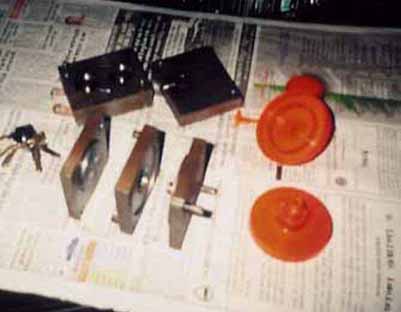
New Improved Earthenware Water Purifiers, a Sneak Preview of Candle Production

Dhaka, Bangladesh March 8, 2002
Earthenware water purification candles are set to be introduced within the coming weeks, to Bangladesh based organizations that are dedicated to safe water options for the poor. Shown above is our press operator,
Mr. G. Mortuja Milon. He is one of our hard working crew, determined to get these low cost, US$0.25
(25 cent) candles to the poor, for 100% removal of the fecal coliforms that cause gastro intestinal diseases.In his left hand he holds a newly produced earthenware candle, in his right an injection molded, plastic cover cap, ready for sealing onto the open end of a fired candle. Then the candle unit will be ready for insertion into the bottom of a clean bucket, to be suspended above a second container which will catch the purified water.
Following is a line tour of the production of these low cost, earthenware water purifiers. We believe that over time these candles will prove sustainable with respect to effectiveness, ease of use and low cost. And since the resources necessary in fabricating the candles are available almost anywhere, this production line is widely replicable.
 |
Photo 2: Parts of the Candle
Die
The production system to be used for the earthenware candles consists of a die and press. Shown here are the parts of the die into which the candle's clay composition is pressed. All exterior parts of the die are made of iron, while those parts which make contact with the clay are made of polished stainless steel. The right hand of Mr. Milon is shown on the spindle, which occupies the space that will become the inside of the candle. Clockwise from the spindle, the other parts include, beneath the left hand, the outer cladding of the die, then the two, half cylinder inserts for this. At bottom right is the cylindrical form used in the first pressing, for compacting the clay composition around the spindle. At bottom left is the form used for the second of the two pressings, to push clay over the top of the spindle, forming the closed end of the candle. |
| Photo: 3: Preparing to Charge
the Die
In this photo Mr. Milon is getting ready to put together the half cylinder, stainless steel inserts. |
 |
 |
Photo 4: Placing the Stainless
Steel Inserts
Together these are pushed into the outer cladding |
| Photo 5: Pouring the Clay Composition
Into the Die
Once the inserts are in place Mr. Milon begins to pour the damp clay composition into the die, around the spindle. He then tamps the material down with a stick, in effect a first pressing. |
 |
 |
Photo 6: The New Improved Screw
Press
After placing the cylindrical form (shown at bottom right in photo 2) into the die, pressure is applied to the clay material, thus compacting it. This is accomplished using this newly designed press, which offers a clear advantage over the hydraulic truck jacks previously used in candle pressing. (Truck jacks are not designed to withstand the repeated use necessary in candle pressing, and the hydraulics tend to fail after a few hundred pressings, or less.) |
| Photo 7: Preparing for the Second
Pressing
Following the first pressing additional clay composition is poured into
the die, on top of the spindle, as shown here. Then Mr. Milon places
into the die the form shown at bottom left of
|
 |

Photo 8: Removing the Candle from the Stainless Steel Insert
After the second pressing the candle is removed, the equipment ready for another candle. The entire process of forming a candle by the method shown takes about 5 minutes for a single operator, but with several helpers this time is reduced substantially.
Following this forming process the candles are dried then fired to about
800 degrees centigrade. This step gives them the strength necessary
in ensuring a long lifetime. Prior to sale of the candles the last
step is to saturate these with a very tiny amount of silver, the anti microbial
which acts with the filtration process in ensuring the 100% removal of
harmful bacteria.

Photo 9: The Injection Mold, for Forming the Plastic Cover Caps of the Candle
The plastic cover cap is made using the injection mold shown here. This mold, the die and press shown in this photo essay cost $450.00. Along with the simple kiln and other processing equipment necessary in fabricating the candles these allow for a startup cost of less than $1000, or in some cases no more than about $400.00.
The candle price will be kept low by getting village potters producing them around the country. Thus the poor will be purchasing water purifiers made near their own community, by small entrepreneurs of similar means. Because of appropriate technology with respect to use of the candle, and it's manufacture, this offers an attractive alternative to the arsenic tainted water from tube wells. This alternative makes possible the collection of surface water.
Reid Harvey
Ceramic Industrial Design Consultant
ceramics@bol-online.com
The Arsenic Research Group
gem@global-bd.net
Dhaka, Bangladesh
To read a recent presentation indicating why earthenware candles
have excellant permeability, click:
http://phys4.harvard.edu/~wilson/remediation/ACER.html
Click
here to see Reid Harvey's c. v.